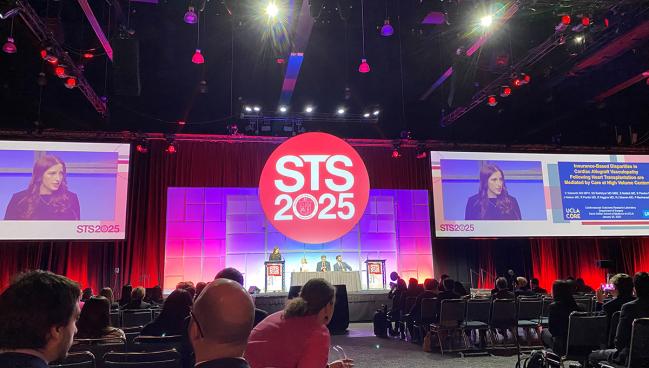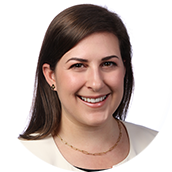Transplant Recipients on Medicaid More Likely to Develop Allograft Vasculopathy
Treatment at a high-volume center mitigated the risk, prompting questions about what these hospitals are doing better.

LOS ANGELES, CA—Within 5 years of heart transplant, patients with Medicaid insurance are more likely to suffer from cardiac allograft vasculopathy (CAV)—a leading cause of mortality in these individuals—compared with those holding other types of insurance, according to new US registry data. Notably, though, patients who receive care at high-volume centers are less likely to be subject to this disparity.
“I want to underscore that there is no biological link between insurance and transplant outcomes,” said Sara Sakowitz, MS, MPH (UCLA Geffen School of Medicine, Los Angeles, CA), who presented the findings in a plenary session last weekend at the 2025 Society of Thoracic Surgeons (STS) Annual Meeting. “The incidence of CAV has been traced to cardiovascular risk factors, including obesity, diabetes, and smoking. Posttransplant metabolic syndrome, including steroid or immunosuppression induced hyperlipidemia, can also contribute to endothelial dysfunction. And so it’s particularly relevant that socioeconomic disadvantage has been linked with a higher prevalence of metabolic risk factors and cardiovascular disease.”
Previous findings from Sakowitz and colleagues have clarified the link between socioeconomic status, especially where patients live, and posttransplant outcomes. The new data build upon the evidence potentially unlocking doors to change course for patients who receive the life-altering gift of a heart transplant.
Medicaid Outcomes
For the study, Sakowitz and colleagues looked at data from the Organ Procurement and Transplantation Network on 33,533 adult heart transplant patients treated between 2004 and 2023. Almost half (49%) were insured privately, but 34% had Medicare, 13% Medicaid, and 4% other health insurance.
The primary endpoint of CAV at 5 years was noted in 31% of patients. Compared with private insurance, Medicaid was associated with an increased risk of CAV even after adjustment for patient and neighborhood sociodemographic factors and clinical status (HR 1.14; 95% CI 1.03-1.27). Additionally, Medicaid insurance was associated with worse patient (HR 1.32; 95% CI 1.23-1.41) and allograft survival over 5 years (HR 1.31; 95% CI 1.22-1.41).
Interestingly, neighborhood socioeconomic disadvantage was not associated with CAV risk in this analysis.
Center volume played a role in outcomes: patients with Medicaid treated at a high-volume hospital saw no higher risk of CAV compared with those holding private insurance (HR 1.05; 95% CI 0.60-1.85), but those treated in non-high-volume centers did (HR 1.28; 95% CI 1.08-1.51).
What surprised Sakowitz most about the findings was not the link between insurance and CAV that they found, but rather that it seems to have emerged following the introduction of the Affordable Care Act in 2014.
She said this is likely because of the “51% increase” in heart transplantations performed in Medicaid insured patients after 2014. “But expanded access to heart transplant alone does not adequately address persistent barriers to medication for follow-up care,” Sakowitz argued.
Surgeons are faced with competing priorities in ensuring patient access to care but also in providing high-quality care, she said. “Making sure both of those goals are met requires that together we share information, we disseminate best practices, and we establish standards that can be shared across low and high-volume programs.”
Specific examples of this might include consistent CAV screening and conducting research to better understand the mechanisms behind CAV as a wat to come up with better treatments, Sakowitz suggested.
More Work Outside the OR
Discussing the study during the session, John Trahanas, MD (Vanderbilt University Medical Center, Nashville, TN), noted that the analysis is “robust” but warned against relying too much on the findings to make conclusions about biology.
“The database collects a lot of information, but we must not forget that fundamentally, it is an administrative database and it is not designed for clinical studies,” he said. “When we use it to explore complex issues and variables beside the very concrete endpoint of death, we must be cautious.”
Though CAV is “ever the Achilles’ heel of clinical heart transplantation,” classifying its potential causes through this dataset “creates more questions than answers in the current setting,” Trahanas said. “I’m concerned that the deep flaws of how the data is entered and our own limitations in CAV surveillance are not fully appreciated or acknowledged.”
Because of these limitations, Sakowitz said she doesn’t want her data used to justify closure of programs at lower-volume centers. “Anytime you close a program, in part that actually creates more barriers for patients with disadvantage to access care,” she said. “But the larger problem is I don’t think we’re there yet because we don’t have enough information.”
The mechanism tying higher-volume centers to better CAV outcomes remains unknown, Sakowitz stressed. “Is it the presence of ancillary care teams? Is it that they’ve delineated specific care algorithms regarding screening or early prevention or treatment of CAVs? Some of those resources may require investment small programs don’t have, but some of the care algorithms or care pathways may be able to be disseminated more easily across hospitals, keeping those low-volume centers open and allowing transplant patients to receive their care there, but actually improving, CAV outcomes for all patients across the US.”
Not only would she like to see more research on CAV and the mechanisms behind it, but Sakowitz also called for the field to look more closely at interventions that can improve and lengthen the lives of transplant recipients.
“For so long we have been focused on ensuring patients who require a transplant can access it, and of course that’s a critical first step,” she said. “A transplant patient faces a very challenging life course. They face medications that they have to take for the rest of their life. They face required clinical follow-ups and check-ins. We can no longer stop at the point of transplant.”
Yael L. Maxwell is Senior Medical Journalist for TCTMD and Section Editor of TCTMD's Fellows Forum. She served as the inaugural…
Read Full BioSources
Sakowitz S. Insurance-based disparities in the incidence of cardiac allograft vasculopathy following heart transplantation are mediated by follow-up care at high volume centers. Presented at: STS 2025. January 25, 2025. Los Angeles, CA.
Disclosures
- Sakowitz reports no relevant conflicts of interest.





Comments